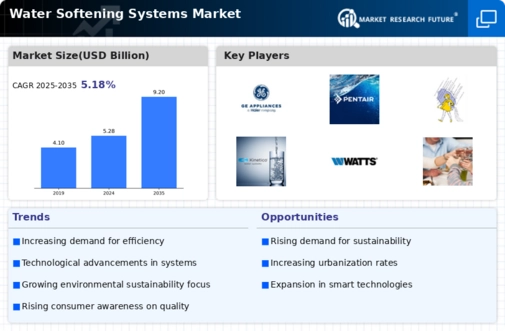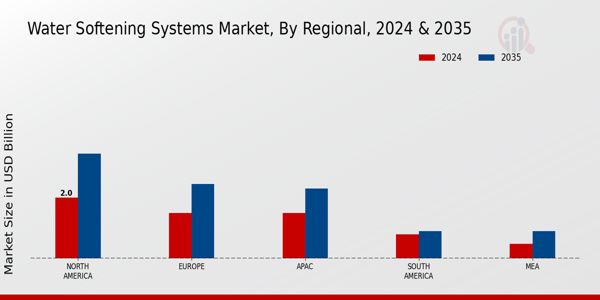Market Growth Projections
The Global Water Softening Systems Market Industry is poised for substantial growth, with projections indicating a market size of 5.28 USD Billion in 2024 and an anticipated increase to 9.2 USD Billion by 2035. This growth trajectory suggests a compound annual growth rate (CAGR) of 5.18% from 2025 to 2035. Such figures reflect the increasing recognition of the importance of water treatment solutions in both residential and commercial sectors. The market dynamics are influenced by various factors, including technological advancements, regulatory support, and rising consumer awareness, all contributing to a robust growth environment for water softening systems.
Increasing Water Quality Concerns
The Global Water Softening Systems Market Industry is experiencing growth driven by rising concerns regarding water quality. Hard water, which contains high levels of calcium and magnesium, can lead to scale buildup in plumbing and appliances, reducing efficiency and lifespan. As consumers become more aware of these issues, the demand for water softening systems is likely to increase. In 2024, the market is projected to reach 5.28 USD Billion, indicating a strong consumer shift towards solutions that enhance water quality. This trend is particularly evident in regions with naturally hard water, where households are increasingly investing in softening systems to mitigate the adverse effects of hard water.
Growing Awareness of Health Benefits
Consumer awareness regarding the health benefits of softened water is significantly influencing the Global Water Softening Systems Market Industry. Softened water is often perceived as healthier for drinking, cooking, and bathing, as it reduces skin irritation and improves the taste of water. This growing awareness is prompting more households to invest in water softening systems, particularly in regions where hard water is prevalent. As the market continues to expand, it is likely that educational campaigns and health studies will further reinforce the benefits of softened water, driving demand. The projected CAGR of 5.18% from 2025 to 2035 suggests a sustained interest in health-oriented water treatment solutions.
Regulatory Support for Water Treatment
Government regulations aimed at improving water quality and safety are significantly influencing the Global Water Softening Systems Market Industry. Many countries are implementing stricter standards for water treatment, which encourages the adoption of water softening technologies. For instance, regulations that mandate the reduction of hard water minerals in municipal water supplies are prompting both residential and commercial sectors to invest in softening systems. This regulatory support not only enhances public health but also drives market growth, as businesses and homeowners seek compliance with these standards. The anticipated growth in the market underscores the importance of regulatory frameworks in shaping consumer behavior and industry practices.
Rising Residential and Commercial Construction
The ongoing expansion in residential and commercial construction is a key driver for the Global Water Softening Systems Market Industry. As new buildings are constructed, the incorporation of water softening systems is becoming increasingly common, particularly in areas with hard water. This trend is evident in both urban and suburban developments, where builders recognize the long-term benefits of installing these systems for their clients. The market is projected to grow to 9.2 USD Billion by 2035, reflecting the increasing integration of water softening solutions in new constructions. This growth is indicative of a broader recognition of the value of water treatment technologies in enhancing property value and sustainability.
Technological Advancements in Softening Systems
Technological innovations are playing a pivotal role in the evolution of the Global Water Softening Systems Market Industry. Advancements such as smart water softeners equipped with IoT capabilities allow users to monitor and control their systems remotely, optimizing performance and efficiency. These innovations not only enhance user experience but also contribute to water conservation efforts. As technology continues to evolve, it is expected that the market will see an influx of more efficient and user-friendly products. This trend is likely to attract a broader consumer base, further propelling market growth as the industry adapts to the demands of modern consumers.















Leave a Comment